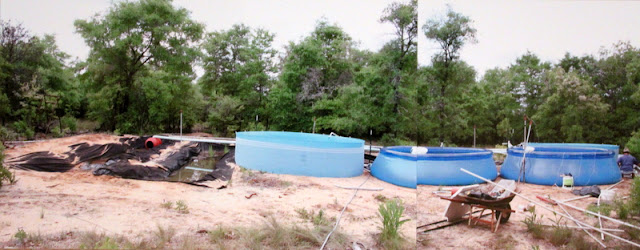It began years ago, while we planned and dreamed about one day owning land and working towards a more self sufficient lifestyle. We read an article in a Reader's Digest homestead skills book about raising tilapia in swimming pools. The article claimed that these African cichlids were a vegetarian species and could live on grass clippings. Now THAT was something we could afford! We were immediately hooked and planned that one day we would do this.
Tilapia are a fresh water, African fish. They need warm waters to survive - above 45 degrees, and are a very prolific fish. They are becoming more and more popular as a recognized food source and as a fish farming choice. We wanted to raise tilapia as food for our family, but found, upon researching this topic, that because they are considered an "invasive species", because they multiply rapidly and are not indigenous to the US, there is a fear that they will disrupt the natural ecosystem, (we have our own thoughts about that!) so the state of Florida requires growers to be licensed and periodically inspected, even though Tilapia swim freely and are unregulated in the waters of Florida south of the St Mark's River - which is about 3 hours from here. This we did.
We closed on our property in the fall of 2003 and by the spring of 2005 this is what my husband had set up for our first attempt at fish farming.
Keep in mind we were only coming to the property on the weekends

A hand-dug, in-ground filtration system begins on the left. It is a closed system in which used fish water is pumped into the top of the filtration system (far left) and flows downhill, behind the swimming pools through a lava rock setup designed to capture the fish waste and clean the water. The water empties into a holding tank behind the farthest right hand swimming pool where it collects and is then pumped back into the three pools by means of a float valve and a swimming pool pump, thereby aerating with pools with naturally, cleaned fish water. Because the land here is pure sand, the entire structure is lined in plastic so that the water can be retained and not seep immediately into the ground. The water is cleaned by a combination of exposure to sunlight, plants, aerobic bacteria in the exposed water, and a septic tank feeder hose buried beneath a sand bed to harbor anaerobic bacteria which further breaks down the waste - similar to a septic tank. This combination of exposed sunlight and anaerobic action of sand filtered bacteria mixed together produce as natural a filtration system as can be put together by man. God does this in the natural ecosystem.
You'll see later modifications and revelations in future articles.
Now it was time to get the fish.
what are you going to do with your fish now? can you appeal the decision? y'all put in a lot of work into raising those fish and have a very efficient system in place.
ReplyDeleteNice
ReplyDeletenike air vapormax
ReplyDeletereebok outlet
adidas yeezy
russell westbrook shoes
louboutin
kd 12
zx flux
golden goose
birkin bag
air max 95